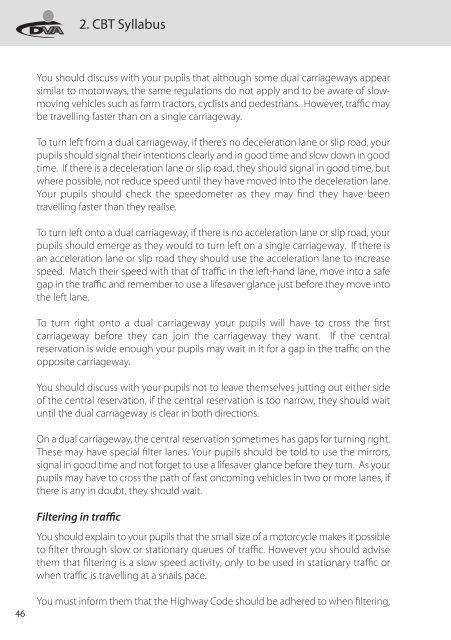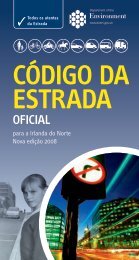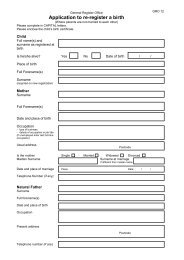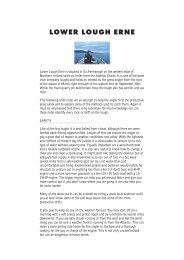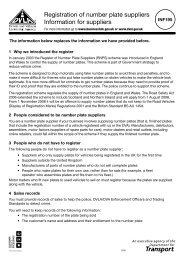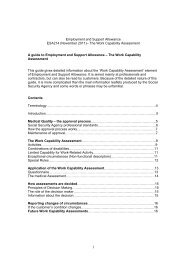an instructors guide to delivering compulsory basic training - NIDirect
an instructors guide to delivering compulsory basic training - NIDirect
an instructors guide to delivering compulsory basic training - NIDirect
You also want an ePaper? Increase the reach of your titles
YUMPU automatically turns print PDFs into web optimized ePapers that Google loves.
46<br />
You should discuss with your pupils that although some dual carriageways appear<br />
similar <strong>to</strong> mo<strong>to</strong>rways, the same regulations do not apply <strong>an</strong>d <strong>to</strong> be aware of slowmoving<br />
vehicles such as farm trac<strong>to</strong>rs, cyclists <strong>an</strong>d pedestri<strong>an</strong>s. However, traffic may<br />
be travelling faster th<strong>an</strong> on a single carriageway.<br />
To turn left from a dual carriageway, if there’s no deceleration l<strong>an</strong>e or slip road, your<br />
pupils should signal their intentions clearly <strong>an</strong>d in good time <strong>an</strong>d slow down in good<br />
time. If there is a deceleration l<strong>an</strong>e or slip road, they should signal in good time, but<br />
where possible, not reduce speed until they have moved in<strong>to</strong> the deceleration l<strong>an</strong>e.<br />
Your pupils should check the speedometer as they may find they have been<br />
travelling faster th<strong>an</strong> they realise.<br />
To turn left on<strong>to</strong> a dual carriageway, if there is no acceleration l<strong>an</strong>e or slip road, your<br />
pupils should emerge as they would <strong>to</strong> turn left on a single carriageway. If there is<br />
<strong>an</strong> acceleration l<strong>an</strong>e or slip road they should use the acceleration l<strong>an</strong>e <strong>to</strong> increase<br />
speed. Match their speed with that of traffic in the left-h<strong>an</strong>d l<strong>an</strong>e, move in<strong>to</strong> a safe<br />
gap in the traffic <strong>an</strong>d remember <strong>to</strong> use a lifesaver gl<strong>an</strong>ce just before they move in<strong>to</strong><br />
the left l<strong>an</strong>e.<br />
To turn right on<strong>to</strong> a dual carriageway your pupils will have <strong>to</strong> cross the first<br />
carriageway before they c<strong>an</strong> join the carriageway they w<strong>an</strong>t. If the central<br />
reservation is wide enough your pupils may wait in it for a gap in the traffic on the<br />
opposite carriageway.<br />
You should discuss with your pupils not <strong>to</strong> leave themselves jutting out either side<br />
of the central reservation, if the central reservation is <strong>to</strong>o narrow, they should wait<br />
until the dual carriageway is clear in both directions.<br />
On a dual carriageway, the central reservation sometimes has gaps for turning right.<br />
These may have special filter l<strong>an</strong>es. Your pupils should be <strong>to</strong>ld <strong>to</strong> use the mirrors,<br />
signal in good time <strong>an</strong>d not forget <strong>to</strong> use a lifesaver gl<strong>an</strong>ce before they turn. As your<br />
pupils may have <strong>to</strong> cross the path of fast oncoming vehicles in two or more l<strong>an</strong>es, if<br />
there is <strong>an</strong>y in doubt, they should wait.<br />
Filtering in traffic<br />
2. CBT Syllabus<br />
You should explain <strong>to</strong> your pupils that the small size of a mo<strong>to</strong>rcycle makes it possible<br />
<strong>to</strong> filter through slow or stationary queues of traffic. However you should advise<br />
them that filtering is a slow speed activity, only <strong>to</strong> be used in stationary traffic or<br />
when traffic is travelling at a snails pace.<br />
You must inform them that the Highway Code should be adhered <strong>to</strong> when filtering,


